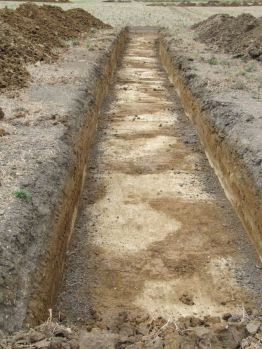Test Pitting

|
| Trench excavation |
"Trenching and test pitting are simple methods of shallow exploration of easily excavated rock or soil materials. Visual inspection of a wide section of strata is of great value in logging profiles and selecting samples. If bedrock is anticipated at a shallow depth, trenches, and test pits should be located on the centerline of the proposed structure and dug parallel with it. If bedrock is not at shallow depths, deep trenches, or test pits should be offset from the centerline to avoid damaging the foundation of the structure. Shallow trenches or test pits may be dug adjacent to the centerline for correlation purposes."[1]
"Where pits or trenches penetrate or pass through foundation materials, trenches are backfilled and compacted to the density of the original in-place material. It is recognized that certain limitations exist in the use of trenching and test-pit excavating equipment for compacting fill material. However, every practical effort should be made to reestablish the in-place densities of foundation materials."[1]
- "Trenches - Trenches are long, narrow excavations. They are advantageous for studying earth materials on steep slopes and in exposed faces. Trenches made by power equipment, such as backhoes, power shovels, and bulldozers, may require hand trimming of the sides and bottom to reach relatively undisturbed material. The method is of particular value in delineating the rock surface beneath the principal spillway and in abutments and in exploring auxiliary spillway materials. Trenching may be the most feasible method of investigation in materials containing cobbles or boulders. Trenches may yield valuable information on potential rock excavation and core trench depth along the centerline of the structure, depending on its design."[1]
- "Test pits - Test pits are large enough to accommodate a person with sampling equipment. They may be excavated by hand or by power equipment such as a clam-shell or orange-pool bucket. Power equipment should be used only for rough excavation and with extreme caution when approaching the depths are which undisturbed samples are to be taken. Cribbing is required in trenches and pits of depths of 5 feet or greater."[1]
Best Practices Resources
Citations:
Revision ID: 4024
Revision Date: 10/21/2022
